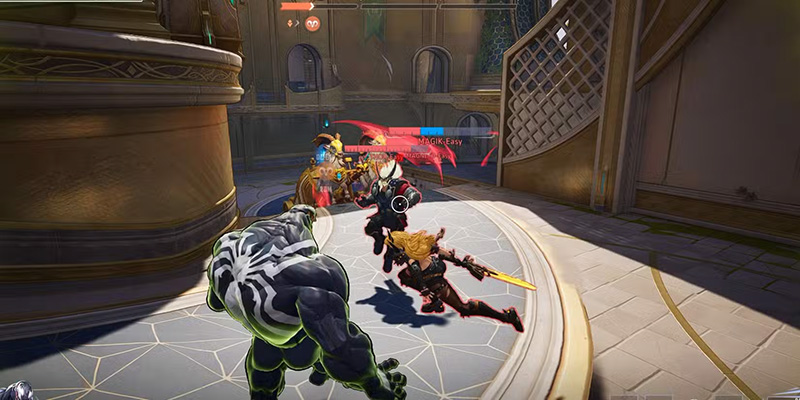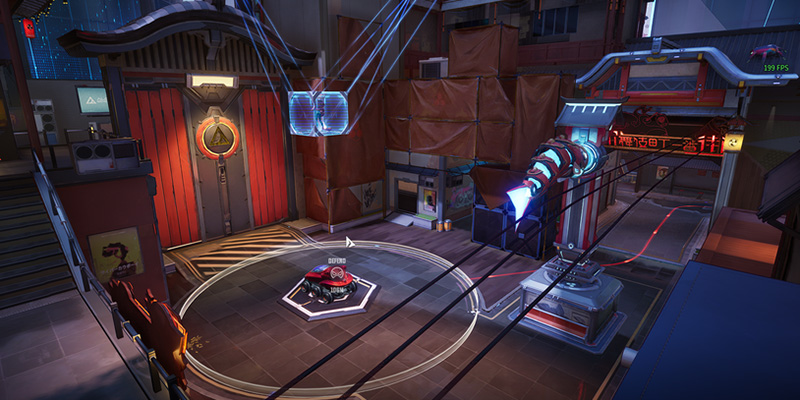Many a hard-fought battle in Marvel Rivals isn't decided by the main timer alone. The true test of a team's mettle often comes in the nail-biting final moments: Overtime, Sudden Death, and the rare but perplexing Draw. These endgame mechanics can be a whirlwind of confusion, but understanding their intricacies is paramount for any player looking to climb the ranks and consistently snatch victory from the jaws of defeat. This guide aims to cut through the fog, offering a clear, data-backed explanation of how these crucial phases operate.
It's important to recognize that Marvel Rivals is a dynamic, evolving battlefield. The information herein is current up to and including Patch Version 20250605 and incorporates details from significant prior updates like Patch 20250218.3 Game mechanics are subject to change, as evidenced by developer efforts to fine-tune these critical endgame moments. For instance, the introduction of a 0.5-second grace period in Overtime via Patch 20250218 3 demonstrates an ongoing refinement process, likely responding to player experiences and the need for fairer, more exciting conclusions. This iterative approach means players should always keep a vigilant eye on official patch notes to stay ahead of the curve.
Overtime: When the Fight's Not Over
Overtime (OT) is the game's way of saying, "Hold on, this isn't finished yet!" It's a lifeline for the team on the brink, offering a chance to turn the tables.
The Golden Rule: Contesting is Key
The fundamental trigger for Overtime across all applicable modes is straightforward: the main game timer must hit zero while the primary objective is actively being contested by the team that is currently "losing" or needs to make progress to avoid a loss. If the objective is completely uncontested by the team that needs to interact with it when that main timer expires, the game or round concludes immediately, no second chances given. That desperate, last-second touch on the payload or point can be the difference between victory and defeat.
The Overtime Timer: A Ticking Clock with Nuances
Once Overtime is triggered, a special OT timer materializes, typically displayed prominently on the HUD. This timer isn't a static countdown; its behavior is influenced by the actions of the players.
- General Behavior: The OT timer will begin to deplete. If this timer runs out while the objective is uncontested by the team that initially forced Overtime, that team loses the Overtime period and, usually, the round or match.
- Contesting's Impact: This is where the real game within the game begins. If the team that forced Overtime maintains a contest on the objective, the OT timer's depletion is significantly slowed, or in many cases, effectively paused. This mechanic is the core of Overtime play – presence on the objective buys precious seconds.
- The "Burn" Rate: To prevent matches from dragging on indefinitely through perpetual stalling, the Overtime timer has a built-in acceleration mechanic. It's widely observed that the longer an Overtime period lasts, or the more frequently control of the objective flips or is contested, the faster the OT bar will deplete when the objective does eventually become uncontested by the team that forced OT. This creates a dynamic where the timer itself becomes a depleting resource for the team trying to make a comeback, but also a mounting pressure.
- No "Stack Caps": Overtime timers do not "stack" in the sense of accumulating multiple instances of bonus time during a single OT phase. However, in multi-round modes like competitive Convoy or Convergence, teams can earn a "time bank" from their performance in earlier rounds.
Convoy Overtime: Pushing Past the Limit
In Convoy, the objective is to escort a payload (Jarnbjorn) to its destination. Overtime here is a desperate push or a stalwart defense.

- Trigger: Overtime activates if the attacking team is contesting (meaning at least one attacker is on or very near the payload) or has control of the payload when the main round timer expires.
- Objective: Attackers must continue to escort the payload towards the next checkpoint or the final destination. If the defending team manages to clear all attackers off the payload and prevent them from re-contesting it before the OT timer (or its "burn" phase) fully depletes, the Overtime ends, and the attackers lose.
- Payload Movement in OT: The standard rules for payload movement remain in effect during Overtime. The payload's speed increases with the number of attackers on it (up to a cap of 3 for maximum speed: 1 attacker = 1.67m/s, 2 attackers = 1.93m/s, 3+ attackers = 2.26m/s, base speed if moving automatically is 1m/s).
Multi-Round Competitive Overtime
This is where Convoy's endgame gets particularly strategic. If both teams successfully escort the payload to the final checkpoint in their respective attacking rounds, the match isn't over. Instead, it proceeds to further Overtime rounds. The time available to each team for these subsequent OT pushes is determined by the amount of time they had remaining on the clock when they completed their initial successful push.
A specific calculation is used: the team with the lesser remaining time typically has their time adjusted (e.g., rounded down to the nearest minute, with a common minimum being 1 minute if their banked time was very low), and the other team receives a comparable adjustment, thereby maintaining their relative time advantage. The team that then manages to push the payload the furthest distance during these "time-bank" Overtime rounds is declared the winner.
Domination Overtime: The Point of No Return
Domination is a battle for control of a single point, typically played as a best-of-three rounds. Overtime here is a frantic, high-stakes skirmish.
A distinct Overtime progress bar appears on the HUD when the capturing team reaches approximately 99% progress and an enemy contests the point.
- Trigger: Overtime occurs when the team capturing a control point reaches approximately 99% progress, and an enemy player steps onto the point to contest it just as the main timer (or the capture progress bar if it's a mid-round capture attempt) is about to complete the capture.
- Objective: The team that was on the verge of winning the point must eliminate all contesting enemies from the objective area. Conversely, the contesting team must maintain their presence to prevent the capture from completing and ideally wrest control of the point themselves.
- Increased Respawn Times: A critical factor in Domination Overtime is that respawn times are increased for both teams once OT is triggered under these 99% contested conditions. This significantly raises the stakes of each elimination.
Convergence Overtime: Two Phases of Pressure
Convergence mode is a hybrid, starting with a point capture phase (like Domination) and then transitioning to a payload escort phase (like Convoy). Overtime can occur in either phase.

- Triggers if attackers are capturing when timer expires
- Behaves identically to Domination Overtime
- Features the "Golden Bar" mechanic
- Potentially increased respawn times
- Triggers if attackers control payload when timer expires
- Behaves identically to Convoy Overtime
- Standard payload movement rules apply
- Time bank system for competitive
Overtime Mechanics Summary
| Game Mode | Trigger Condition | Primary OT Objective | Key Timer Behavior Notes | Grace Time |
|---|---|---|---|---|
| Convoy | Attackers contesting/controlling payload when main timer ends | Continue escorting payload | OT timer depletes; slows/pauses if attackers contest. Faster "burn" if contest broken | Yes (0.5 seconds) |
| Domination | Capturing team at ~99% is contested when capture/timer completes | Capturing team: Clear contesters. Contesting team: Hold | "Golden Bar" depletes if point uncontested. Increased respawn times | Yes (0.5 seconds) |
| Convergence (P1) | Attackers capturing initial point contested when main timer ends | Capture point vs Prevent capture | Behaves like Domination OT | Yes (0.5 seconds) |
| Convergence (P2) | Attackers escorting payload contested/controlling when timer ends | Continue escorting payload | Behaves like Convoy OT | Yes (0.5 seconds) |
Sudden Death: The Ultimate Showdown
"Sudden Death" is a term that refers to specific tie-breaking scenarios that go beyond the standard Overtime extension of a round. It's invoked when a match reaches a stalemate even after regular time and initial Overtime phases have concluded without a clear victor. It's important to understand that "Sudden Death" isn't a single, uniform mechanic across all modes but rather a category of decisive end-game events.
This mode has the most straightforward Sudden Death. If the score is tied when the main timer runs out, the game grants both teams "another chance to score one more point." The first team to score this single point wins immediately.
The multi-round Overtime system using banked time can be considered a form of Sudden Death if it's the final phase determining the match winner after a 3-3 scoreline in objectives pushed. Specific time adjustments can occur based on remaining banked time.
Draws in Ranked: The Unspoken Rules
The question of whether a ranked match in Marvel Rivals can truly end in a draw is a common one, and the answer is nuanced.
Mode-Specific Draw Conditions
- Convoy (Ranked): A draw is exceptionally rare. It typically requires both teams to successfully escort the payload to its final destination during their respective attack rounds, then tie again in subsequent time-bank Overtime rounds.
- Convergence (Ranked): Draws can occur if neither team manages to capture the initial control point, or if both teams complete both phases and tie in time-bank Overtime rounds.
- Domination (Ranked): The general consensus indicates that Domination does not end in a draw in standard ranked play, as it's typically played as best-of-three rounds.
Pro-Tier Tactics: Winning When It Matters Most
Navigating Overtime and Sudden Death successfully requires more than just good aim; it demands composure, strategic thinking, and an intimate understanding of the game's pressure-cooker mechanics.
The Overtime Mindset
Optimal Overtime Decision Flow
Stay calm, communicate clearly about enemy positions and ultimate status, execute coordinated plays, and adapt quickly to changing situations.
Hero-Specific Clutch Plays
Certain heroes possess abilities that are exceptionally powerful in Overtime scenarios. For example, Emma Frost's ultimate, if positioned correctly (potentially using a portal for a surprise angle), can pull multiple enemies off a payload, instantly breaking their contest and winning the round. Heroes with strong displacement abilities (like Magneto or Hulk) or large area-denial ultimates (such as Hela or Star-Lord) can also be game-changers when the objective area is hotly contested.
Stay Updated: The Ever-Evolving Battlefield
The landscape of Marvel Rivals is not static. Balance adjustments, hero reworks, and even modifications to core game mechanics are part of its ongoing evolution.
Key Patch Versions
Recent Updates
In a competitive, live-service game like Marvel Rivals, proactive learning is a distinct advantage. The game is actively patched, and these updates can range from sweeping hero balance adjustments to nuanced rule modifications. Players who stay informed about these changes can adapt their strategies more rapidly than those who remain unaware. Knowledge of the current meta and the precise rule set is a form of power, offering an edge to those who are among the first to understand and leverage new information. Mastering Marvel Rivals is an ongoing journey, and this guide serves as a strong foundation for navigating its most intense moments.
